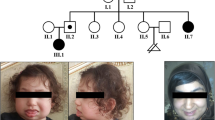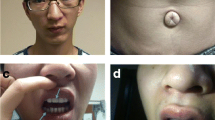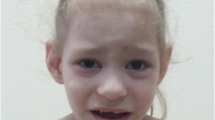Summary
Interstitial cytogenetic deletions involving the paternally derived chromosome 15q11–13 have been described in patients with the Prader-Willi syndrome (PWS). We report a child with PWS and a de novo unbalanced karyotype −45,XY,−9,−15,+der(9)t(9;15)(q34;q13). Molecular studies with the DNA probe pML34 confirmed that only a single Prader Willi critical region (PWCR: 15q11.2-q12) copy was present. Hybridisation of patient and parental DNA with the multi-allelic probe CMW1, which maps to pter-15q13, showed that the chromosome involved in the translocation was paternal in origin. This is the first example of a paternally-derived PWCR allele loss caused by an unbalanced translocation that has arisen de novo.
Similar content being viewed by others
References
Butler MG (1990) Prader-Willi syndrome: current understanding of cause and diagnosis. Am J Med Genet 35:319–332
Donlon TA (1988) Similar molecular deletions on chromosome 15q11. 2 are encountered in both the Prader-Willi and Angelmann syndromes. Hum Genet 80:322–328
Greenberg F, Ledbetter DH (1987) Deletions of proximal 15q without Prader-Willi syndrome. Am J Med Genet 28:813–820
Gregory CA, Kirkilionis AJ, Greenberg CR, Chudley AE, Hamerton JL (1990) Detection of molecular rearrangements in Prader Willi syndrome patients by using genomic probes recognising four loci within the PWCR. Am J Med Genet 35:536–545
Holm V (1981) The diagnosis of Prader-Willi syndrome. In: Holm VA, Pipes PL (eds) Prader-Willi syndrome. University Park Press, Baltimore, pp 27–44
Nicholls RD, Knoll JHM, Butler MG, Karam G, Lalande M (1989) Genetic imprinting suggested by maternal heterodisomy in non-deletion Prader-Willi syndrome. Nature 342:281–285
Mattei MG, Souiah N, Mattei JF (1984) Chromosome 15 anomalies and the Prader-Willi Syndrome: cytogenetic analysis. Hum Genet 66:313–334
Old JM, Higgs DR (1983) Gene analysis. In: Weatherall DJ (ed) The thalassaemias. (Methods in hematology, vol 6) Churchill Livingstone, Edinburgh, pp 74–102
Rich DC, Witkowski CM, Summers KM, Tuinen P van, Ledbetter DM (1988) Highly polymorphic locus D15S24 (CMW-1) maps to 15pter-q13 (HCM9 provisional no D15S24). Nucleic Acids Res 16:8740
Smith A (1986) Chromosome findings in the Prader-Willi syndrome. Aust N Z J Dev Disabil 12:13–28
Tantravahi V, Nicholls RD, Stroh H, Ringer S, Neve RL, Kaplen L, Wharton R, Wurster-Hill D, Grahem JM, Cantu ES, Frias JL, Kousseff BG, Latt SA (1989) Quantitative calibration and use of DNA probes for investigating chromosome abnormalities in the Prader Willi syndrome. Am J Med Genet 33:78–87
Author information
Authors and Affiliations
Rights and permissions
About this article
Cite this article
Smith, A., Lindeman, R., Volpato, F. et al. A de novo unbalanced reciprocal translocation identified as paternal in origin in the Prader-Willi syndrome. Hum Genet 86, 534–536 (1991). https://doi.org/10.1007/BF00194651
Received:
Issue Date:
DOI: https://doi.org/10.1007/BF00194651




